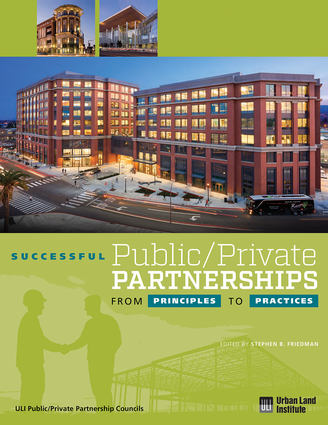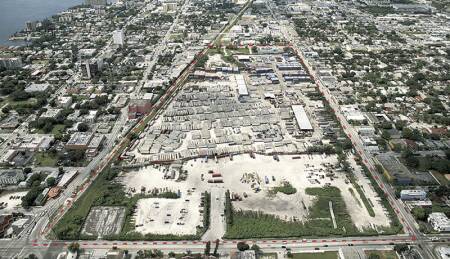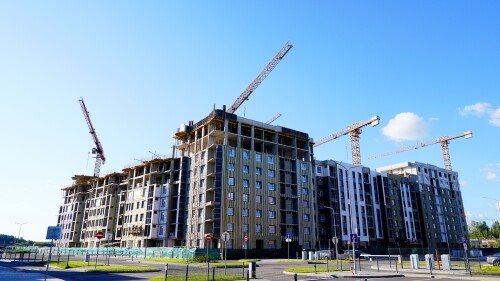 Public/private partnerships (PPPs)—collaborations between the public and private sectors—are increasingly important vehicles to facilitate high-quality development and redevelopment and creation of public facilities and infrastructure.
Public/private partnerships (PPPs)—collaborations between the public and private sectors—are increasingly important vehicles to facilitate high-quality development and redevelopment and creation of public facilities and infrastructure.
Though PPPs are not new, they are being used more widely in a variety of new contexts and are evolving to take more extensive and complicated forms of shared risk and responsibility. These changes will accelerate if the federal government moves forward with broad public investment to modernize infrastructure through the use of tax credits to engage the private sector.
There is a very good chance that the projects that will make a developer most proud in the future will involve a greater public role. Thus, it is timely to reexamine public/private partnerships and their particular challenges.

Miami’s largest PPP, for the Midtown Miami project (below), is redeveloping land formerly used to store shipping containers (above). Zyscovich Architects is the site’s master planner and master architect. The redevelopment includes retail, residential, and commercial/entertainment space. (© Zyscovich Architects)
Key Activities Using PPPs
A number of key types of development activity increasingly use PPPs.
Redevelopment. Redevelopment has long been a public/private enterprise, with public sector engagement primarily involving land acquisition and gap financing. But much has changed since the 1950s and 1960s, when urban renewal programs focused directly on blight removal. Today, redevelopment encompasses such projects as transit-oriented development on underused publicly owned real property (such as surface parking lots surrounding mass transit infrastructure) and mixed-use development of railroad properties and former industrial land, military bases, and decommissioned airports, as well as other infill opportunities.
The early urban renewal programs were followed in the late 1970s by Urban Development Action Grants (UDAGs), which still maintained a strong federal role in urban redevelopment but required developers and localities to have a meeting of the minds on the project to be built.
Over time, the direct federal role in redevelopment has diminished, being replaced by incentives such as tax increment financing; tax abatement/payments in lieu of taxes (PILOT); historic, low-income, and New Markets tax credits; and various forms of community improvement district mechanisms. Municipal bond financing is a frequent companion to these programs. Such financing requires detailed underwriting of feasibility to determine if the new development will be able to pay for itself with the aid of such mechanisms.
Infrastructure development. Beyond the traditional requirements of off-site improvements such as traffic mitigation, infrastructure development has largely become the responsibility of the developer as a prerequisite for obtaining entitlements for projects.
The obligations, often involving extension of public infrastructure systems such as those handling water and wastewater, may require the developer to advance funds and use recapture agreements to recover its investment, adding a layer of public/private engagement to the process. Privately owned water systems are common, and developer financing with public approval of systems adds new complexity.
Again, public/private vehicles such as community improvement districts may replace or backstop the role of homeowners associations, adding a new layer of public sector involvement and approvals.
Public and community facilities. Public and community facilities have become more complex and now are more likely to involve public, private, and not-for-profit entities in their development and financing. Where once public bodies may have used a design-build/sale-leaseback arrangement to tap private expertise and financing for a public facility, these arrangements have evolved to include private responsibility for operations and maintenance in exchange for an “availability payment” from the public entity.
Community centers, charter schools, training centers, museums, libraries, health centers, and theaters, among others, now may be developed by not-for-profit entities using New Markets Tax Credits layered with areawide tax increment financing funds, or similar funding mechanisms. They may also use tax-exempt bonds as part of the financing.
Major transit and transportation facilities. Increasingly development of transit and transportation facilities has relied on mixed private/public financing derived from fares and tolls supplemented by tax increment financing, special assessments, or community improvement districts, as well as developer exactions or general public revenues. This helps the government entity capture some of the value created by the facility to help pay for its development.
This value capture process results in very complex financing structures. Numerous cities—including Chicago, Denver, Los Angeles, Oklahoma City, and Seattle—have passed new taxes or created tax increment districts to support transit, using the funds to secure a local match for federal transit grants or to supplement revenue from fare boxes and tolls, or both. These are the kinds of facilities that could benefit from the type of infrastructure tax credit advocated by the new administration because fares and value capture could provide the balance of funds needed for the project.
Increased Complexity
Such next-generation, more complex PPP projects share a number of elements, including the following:
They require deep engagement with government authorities—including local, state, and federal governments and special entities—that goes well beyond the traditional seeking of entitlements for support of real estate development.
They involve financial complexity—and rules and regulations—different from and greater than the rules affecting many traditional real estate projects.
They are often discretionary—with approval based on such factors as financial gaps, the need for public facilities, limited availability of credits, and competitive allocation rather than on the assistance one is entitled to once certain rules are met.
They are deeply tied to the public agenda and to public needs as reflected in agency plans, priorities, or defined facilities. The focus on public benefits introduces a different political and risk-allocation dynamic to the transaction.
Different Practices
As a result of all these elements, many more stakeholders and participants of all kinds are involved in conceiving and approving such projects, and a specialized skill set and unique vision are required in order for them to be executed successfully. Engaging in these types of projects calls for different practices than might be typical for traditional private development. These include the following:
Creating a shared vision and public purpose. In a traditional development, the public’s view may be expressed through zoning requirements, and the developer defines the project within market and regulatory constraints. But if a combination of public and private funding is involved, there must be a deeper engagement between the public and private sectors and a reconciliation of their purposes and agendas.
Inevitably, this requires deep engagement, not only with local appointed and elected officials, but also with stakeholders that may include myriad other public agencies, not-for-profit organizations, local philanthropists, major companies and institutions such as universities and hospitals, and the public at large. The processes to arrive at a shared vision require more time and expense and, often, a more deft political touch.
Assembling the development team. The development team for PPP projects will have more members and require special expertise serving both the private parties and the public sector. This may range from greater skill in facilitating public dialogue to the highly specific skills of municipal advisers, redevelopment counsel, bond counsel, and the like. Developers new to the public/private arena often underestimate the importance of specialized expertise to achieving a successful transaction.
Engaging in proactive predevelopment. The predevelopment process is intrinsically more complex and entails more time, cost, and risk for a project that can only be accomplished as a PPP. In PPPs, land acquisition, demolition, and often cleanup can present unique challenges when compared with a typical development transaction and, thus, can be more costly and time-consuming. These risks are often difficult for the private sector to bear—and the public sector may not be certain of the outcome should it proceed without a developer.
In facility PPPs and infrastructure PPPs, part of what is involved is often shifting responsibility for the design, construction, and long-term operation to the private sector, necessitating that the public sector have a very detailed and clear understanding of its requirements for the facility and its operation.
Creating relationships. Public procurement regulations can make establishing relationships between developers and public entities involved in a PPP complex and filled with risk for both sides.
The public entity is not motivated in the same way the private sector is. The public sector is focused on goals and is motivated by avoiding risk, avoiding failure, and politics. In contrast, the private sector is focused on achieving the highest price at the lowest cost and with minimal ongoing compliance obligations, such as specialized reporting and recordkeeping required by public financing sources. For its part, the private sector often is stymied by a perceived lack of public sector understanding of private capital underwriting criteria.
How much can the private developer provide in project specifications upfront if there is no commitment on the part of the public entity to proceed? What are the specific mechanisms available in a jurisdiction to select a developer and complete a transaction? Under what circumstances should one use a design/build/operate model rather than a design/bid/build model for public facilities in order to secure the potential savings? Strong working relationships are critical to bridge this divide.
Making a fair deal. The public sector should not be putting more public funds into a deal than is required for the project to provide a commercially reasonable return to investors while meeting the public goals. Whether specifically embedded in the law or not, husbanding public funds is a fiduciary responsibility of public officials. But how do the public and private sectors know where the balance lies?
Answering this requires deep and careful financial analysis of the project at hand—a process in which the private sector must be prepared to disclose more than it may like and which the public sector needs to undertake with more seriousness and at greater cost than it may have thought necessary. However, the deep analysis of need and structure—often called a gap analysis, or the “but for . . .” test—is the way to fulfill this requirement and allay the valid fears of elected officials.
Assessing fiscal impacts and community benefits. Just because a project has a financing gap does not mean it is worth executing as a partnership. The fiscal and community benefits also must be analyzed to ensure a positive cost/benefit balance, as well as that community needs are being met—a test against the very public policy goals that are the reason for the PPP. These public goals include direct tax benefits, lower public costs, creation of direct and indirect jobs, and often a community benefits agreement demonstrating the benefits and establishing a commitment to provide them.
Structuring the PPP. The financial and business structure of a PPP will vary according to the type of deal and the types of financing involved. In addition to financial tools, many nonfinancial tools exist as well, including rezoning, regulatory relief, and the waiving of fees and exactions, which can be employed before financial tools are used. Layered financing is typical, however, with many sources of such financing to fill the many gaps. For example, the Flats East Bank project in Cleveland—a $750 million waterfront redevelopment that includes an office tower, a hotel, residences, restaurants, and other uses—required more than 30 sources of financing to complete the capital stack.
In PPPs for developing facilities and infrastructure, the roles of fees, rents, tolls, fares, value capture, and others are all critical and must be prudently estimated in determining the structure of the deal.
Sharing risk and reward. One of the most contentious challenges to be overcome in a PPP is arriving at a mutually comfortable agreement on how to share risk and reward. The debate often focuses on the risks that the private sector is taking on the downside, while the public wants to share in the upside potential but not in that downside risk.
What the public sector is bringing to the transaction may be critical: public land brought in at market value justifies sharing if the project is a home run yielding prices to the developer significantly above those initially expected, for example. Construction cost savings on a project with public financing can be shared with the public sector partner while maintaining the developer’s incentive to achieve those savings. At the same time, the developer (including facility and infrastructure entities) must deal with the requirements of its capital sources. On top of that, it is critical that the public sector acknowledge the downside risk and understand the plan for how that risk will be compensated.
To overcome these challenges, each party must thoroughly understand the transaction through the eyes of the other.
Documenting and monitoring deals. Finally, and perhaps most prosaically, all of this complexity and agreement must be properly documented and monitored. Because so many parties and so many elements are involved, this is not a simple matter, even if at the core a developer is simply buying a piece of public land.
Instead of a purchase-and-sale contract, there will be a redevelopment agreement that lays out everyone’s commitments. (Often planned development and redevelopment approval are simultaneous.) The execution must be monitored, often imposing on public sector officials responsibilities they are not accustomed to carrying out and imposing on the developer an unfamiliar layer of additional scrutiny. To a developer unfamiliar with the process, the documentation and monitoring may seem quite unusual.
Why bother with something so complex as a public/private partnership? Because creating great places, healthy places, and sustainable communities requires infill redevelopment, more careful new development, and shared responsibility for facilities and infrastructure—all better achieved through public/private partnerships. The result is a better balance of public and private goals, greater efficiencies, greater rewards, and better development than can be achieved through traditional methods.
Stephen B. Friedman is president of SB Friedman Development Advisors in Chicago. Clayton B. Gantz is a partner at Manatt, Phelps & Phillips in San Francisco.
Successful Public/Private Partnerships: From Principles to Practices, prepared by ULI’s Public/Private Partnership Councils and edited by Stephen B. Friedman, is available at the ULI Bookstore.





